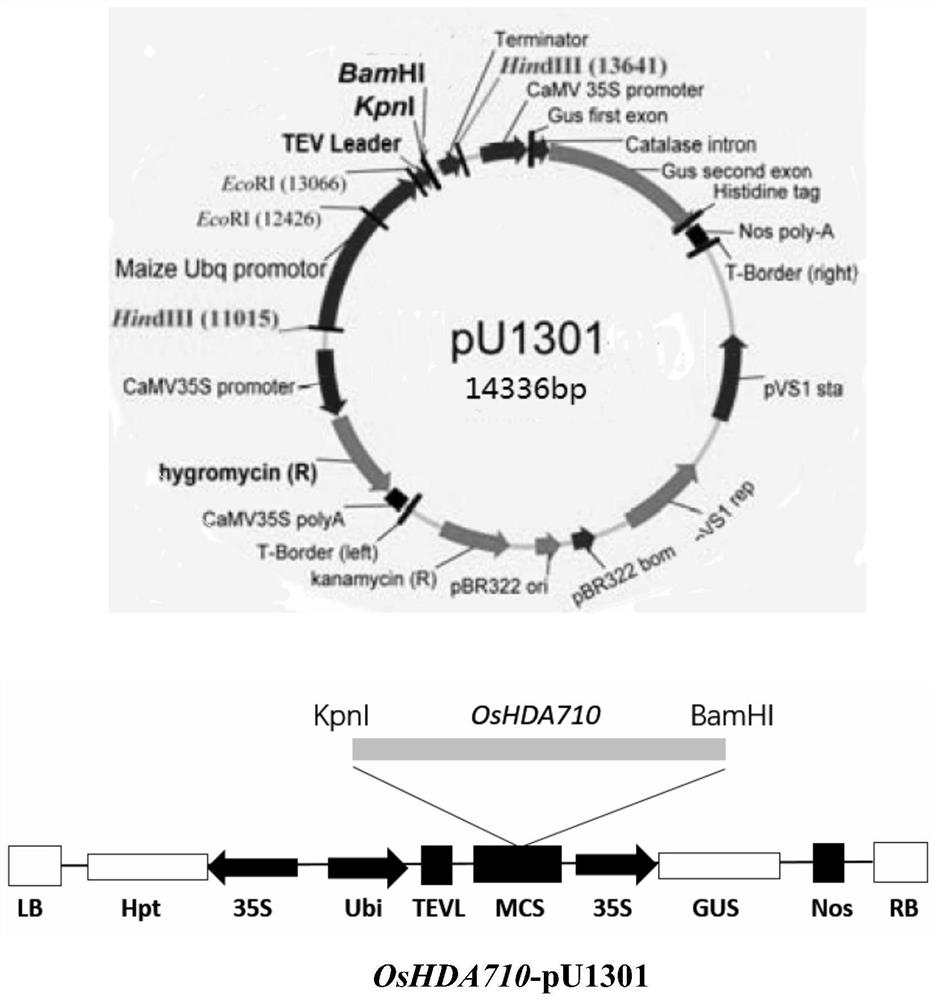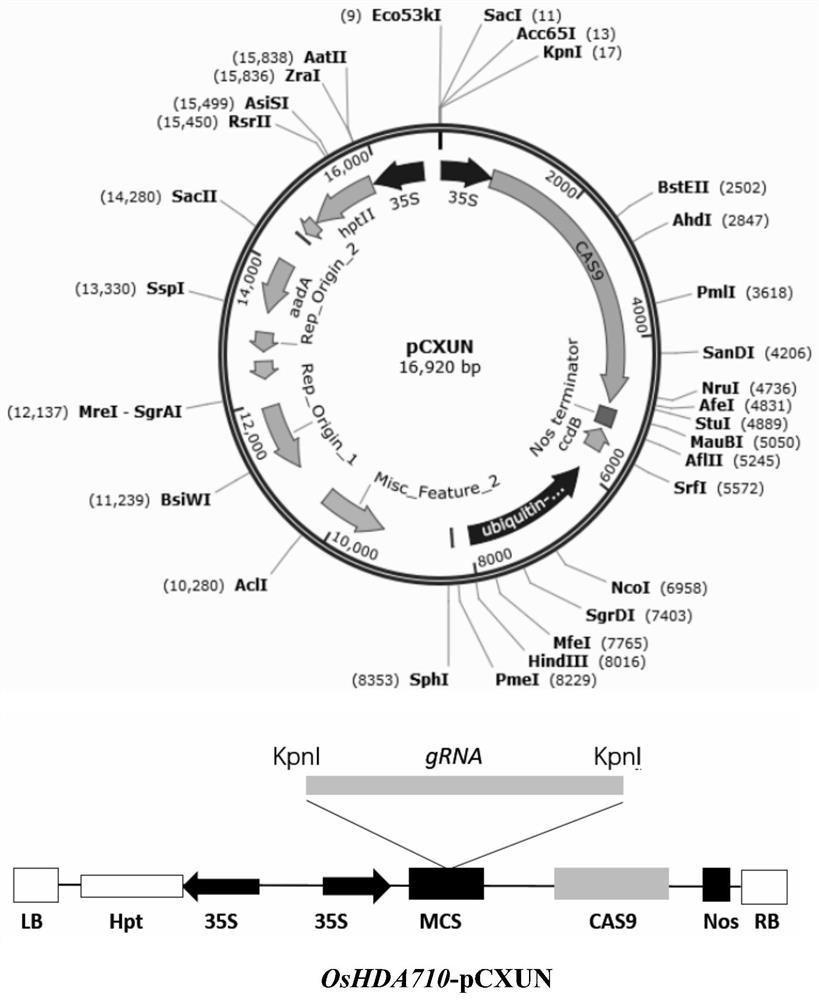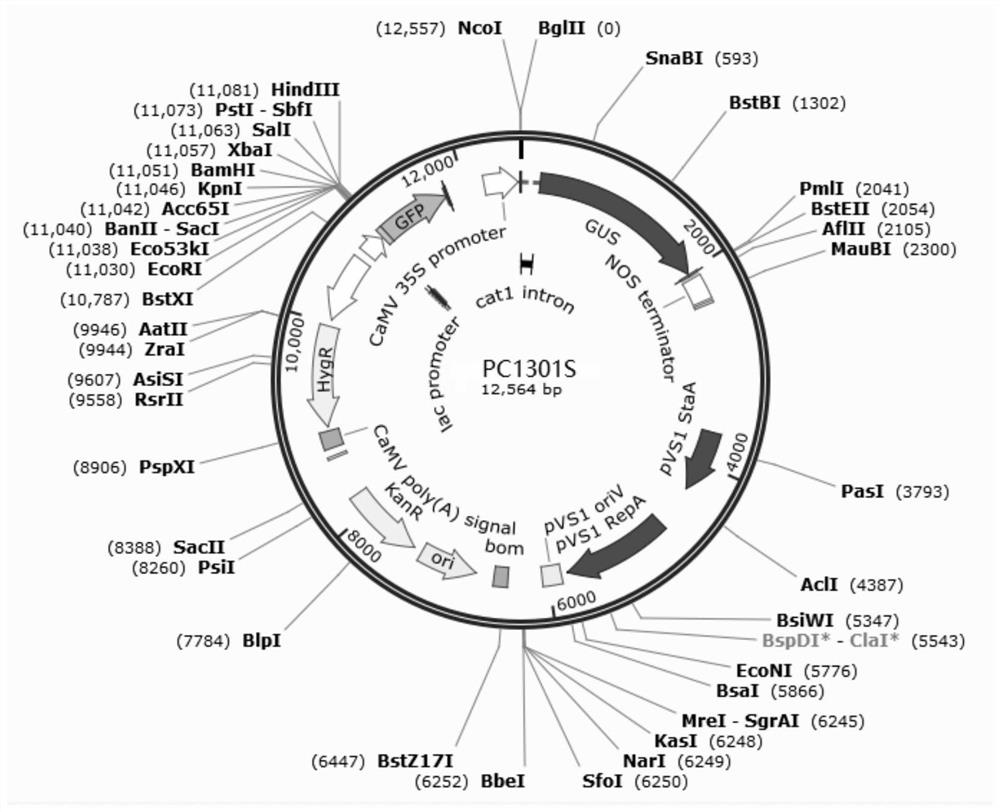Application of OsHDA710 epigenetic regulatory factor gene in rice development and stress resistance
A technology of regulatory factors and epigenetic regulation, applied in the fields of application, genetic engineering, plant gene improvement, etc., can solve the problems that the mechanism of stress resistance has not been elucidated
- Summary
- Abstract
- Description
- Claims
- Application Information
AI Technical Summary
Problems solved by technology
Method used
Image
Examples
Embodiment 1
[0038] Example 1: Cloning of the OsHDA710 gene
[0039] The clone (LOC_Os02g12380) of the gene OsHDA710 of the present invention is mainly obtained by the method of RT-PCR (method reference: J. Sam Brook, EF Fritsch, T Mani Atis, translated by Huang Peitang, Wang Jiaxi, etc., Molecular Cloning Experiment Guide (Third Edition), Science Press, Beijing, 2002 edition). The specific operation steps are as follows:
[0040] (1) Extract RNA from seedling leaves of rice variety "Zhonghua 11" (from Institute of Crop Science, Chinese Academy of Agricultural Sciences), and use Invitrogen's Trizol extraction kit for RNA extraction (see the kit's instruction manual for specific steps);
[0041] (2) RT-PCR reverse transcription to synthesize the first strand of cDNA: ①Preparation of mixed solution 1: total RNA 4μg, DNaseI 2U, 10xDNaseI buffer 1μl, add DEPC (diethyl pyrocarbonate, a strong inhibitor of RNase) treated water (0.01% DEPC) to 10 μl, after mixing, place the mixture 1 at 37°C fo...
Embodiment 2
[0048] Embodiment 2: Construction of OsHDA710 overexpression vector
[0049] (1) Design primers suitable for constructing overexpression vectors and add enzyme-cut linkers of Kpn I and BamH I at both ends of the primers, use the full-length cDNA obtained in Example 1 as a template, and amplify by PCR The CDs sequence of OsHDA710 was obtained.
[0050] (2) digest the PCR product and the overexpression vector plasmid pU1301 with Kpn I and BamH I respectively (see figure 1 ), the target fragment is recovered and purified and connected with ligase, and the connected product is introduced into Escherichia coli DH10B (purchased from Promega (Beijing) Biotechnology Co., Ltd.), in LA containing 250ppm kanamycin (purchased from Roche Biological Company products) (LA formulation is referred to J. Sambrook, EF Fritsch, T Mani Artis, Huang Peitang , translated by Wang Jiaxi, etc., Molecular Cloning Experiment Guide (Third Edition), Science Press, Beijing, 2002 edition) cultured on resi...
Embodiment 3
[0054] Embodiment 3: Construction of CRISPR / CAS9 vector
[0055] According to the full-length sequence of the OsHDA710 gene obtained in Example 1, the gRNA sequence was designed, and the U3-promoter-gRNA sequence was constructed by fusion PCR, and then the cloned plasmid was digested with KpnI, and finally connected to the pCXUN- On the Cas9 vector, positive clones containing foreign fragments were screened.
[0056] Specific steps: Find the target site for knockout, using the website CRISPR-P developed by the Bioinformatics Center of the State Key Laboratory of Crop Genetic Improvement, Huazhong Agricultural University (Lei et al 2014; Liu et al 2017). Copy the genome sequence or coding region sequence of the target gene to the homepage of the website, execute the search function, and select the point with the fewest possible off-target sites and the highest Score as the target site at the 5′ end close to the gene coding region sequence, and design primers.
[0057] The CRI...
PUM
 Login to View More
Login to View More Abstract
Description
Claims
Application Information
 Login to View More
Login to View More - R&D
- Intellectual Property
- Life Sciences
- Materials
- Tech Scout
- Unparalleled Data Quality
- Higher Quality Content
- 60% Fewer Hallucinations
Browse by: Latest US Patents, China's latest patents, Technical Efficacy Thesaurus, Application Domain, Technology Topic, Popular Technical Reports.
© 2025 PatSnap. All rights reserved.Legal|Privacy policy|Modern Slavery Act Transparency Statement|Sitemap|About US| Contact US: help@patsnap.com



